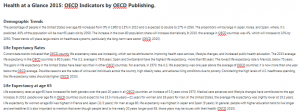Health at a Glance 2015: OECD Indicators by OECD Publishing.

Demographic Trends
The percentage of people in the United States over age 65 increased from 9% in 1960 to 15% in 2010 and is expected to double to 27% in 2050. The proportions will be large in Japan, Korea, and Spain, where, it is predicted, 40% of the population will be over 65 years old by 2050. The increase in the over-80 population share will increase dramatically. In 2010, the average in OECD countries was 4%, which will increase to 10% by 2050. These trends will place large strains on healthcare systems, particularly the long-term care sector (OECD, 2015).
Life Expectancy Rates
Current data trends indicated that OECD-country life expectancy rates are increasing, which can be attributed to improving health care services, lifestyle changes, and increased public health education. The 2013 average life expectancy in the OECD countries is 80.5 years. The U.S. average is 78.8 years. Spain and Switzerland have the highest life expectancy, more than 80 years. The lowest life expectancy rate is Mexico’s, below 75 years. The gains in life expectancy in the United States have been less than in other OECD countries. For example, in 1970, the U.S. life expectancy was one year above the average of OECD countries; it is now more than one year below the OECD average. Possible reasons are the rates of uninsured individuals across the country, high obesity rates, and adverse living conditions due to poverty. Considering the high levels of U.S. healthcare spending, the life expectancy rates should be higher (OECD, 2015).
Life Expectancy at age 65
Life expectancy rates at age 65 have increased for both genders over the past 20 years in all OECD countries: an increase of 5.5 years since 1970. Medical care advances and lifestyle changes have contributed to the age increase. In 2013, people over age 65 in OECD countries could expect to live 19.5 more years—21 years for women and 18 years for men. In the United States, the average life expectancy was slightly lower at 19.2 years. Life expectancy for women at age 80 was highest in France and Japan (11.5 years); for men at age 80, life expectancy was highest in Japan and Spain (9 years). In general, people with higher education tend to live longer and are healthier. It is also important to mention that even though people tend to live nearly 20 years longer post 65, those years may be issues with their health (OECD, 2015).
Figure 3-2 Share of the Population Aged over 65 and 80 Years, 2010 and 2050
Health at a Glance 2015: OECD Indicators by OECD Publishing. Reproduced with permission of OECD Publishing via Copyright Clearance Center
Figure 3-3 Trends in the Share of the Population Ages
Health at a Glance 2015: OECD Indicators by OECD Publishing. Reproduced with permission of OECD Publishing via Copyright Clearance Center
Figure 3-4 Life Expectancy at Age 65, 1970 and 2013 (or Nearest Years)
Health at a Glance 2015: OECD Indicators by OECD Publishing. Reproduced with permission of OECD Publishing via Copyright Clearance Center
Figure 3-5 Life Expectancy at Age 65 by Sex, 2013 (or Nearest Year)
Health at a Glance 2015: OECD Indicators by OECD Publishing. Reproduced with permission of OECD Publishing via Copyright Clearance Center
Life Expectancy by Gender and Educational Level
In all OECD countries, women’s life expectancy rates are much higher than those of men. The 2013 average OECD life expectancy rate for women is 83.1 years, compared to men’s 77.8 years.
Figure 3-6 Healthy Life Years at Age 65, European Countries, 2013
Health at a Glance 2015: OECD Indicators by OECD Publishing. Reproduced with permission of OECD Publishing via Copyright Clearance Center
Figure 3-7 Life Expectancy at Birth by Sex, 2013 (or Latest Year)
Health at a Glance 2015: OECD Indicators by OECD Publishing. Reproduced with permission of OECD Publishing via Copyright Clearance Center
In the United States, the life expectancy is less than the average of the OECD countries with a widening gap with the leading countries. In 2013, the U.S. mens’ life expectancy was 4.3 years less than that of the leader, Switzerland (up from less than 3 years in 1970). In 2013, the U.S. women’s life expectancy rate was 5.4 years shorter than that of the leader, Japan (there was no gap in 1970). This gap may be due in part to our high obesity rates which are a significant risk factor for diseases (OECD, 2015).
Figure 3-8 Gap in Life Expectancy at Age 30 by Sex and Educational Level, 2012 (or Latest Year)
Health at a Glance 2015: OECD Indicators by OECD Publishing. Reproduced with permission of OECD Publishing via Copyright Clearance Center
According to OECD data, those individuals with the highest level of education live 6 years longer than those with the lowest level of education. There was an average gap of 8 years in educational levels in the men’s life expectancy (OECD, 2015).